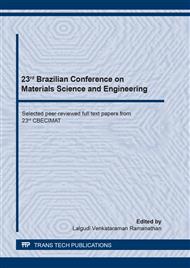p.291
p.296
p.302
p.308
p.314
p.319
p.325
p.331
p.337
PrFeB Based Alloys Obtained by Melt Spinning for the Production of Permanent Magnets
Abstract:
Rare earth permanent magnets are essential components in many fields of technology due to their excellent magnetic properties. There are some techniques used in the manufacture of permanent rare earth magnets: the powder metallurgy to obtain anisotropic HD sintered permanent magnets and the melt spinning and HDDR processes to obtain isotropic and anisotropic bonded permanent magnets. In this work, the influence of the melt spinning parameters on the microstructural and magnetic properties of the Pr14FebalCo16B6 alloy was studied. The alloy was melted and rapidly cooled at 9.9 x 105°C/s. The parameters used in the process were: wheel speed of 15 m/s and 20 m/s and ejection pressure of 25.3 kPa and 50.7 kPa. Ribbons and/or flakes of 30 μm thickness and width until 5 mm were obtained. Results show that the melt spinning alloys are nanocrystalline and that the parameters of the process influence the microstructure and their magnetic properties. Mean crystallite size up to 38.5 nm and intrinsic coercivity (iHc) up to 254 kA/m were obtained.
Info:
Periodical:
Pages:
314-318
Citation:
Online since:
October 2020
Keywords:
Price:
Сopyright:
© 2020 Trans Tech Publications Ltd. All Rights Reserved
Share:
Citation:


